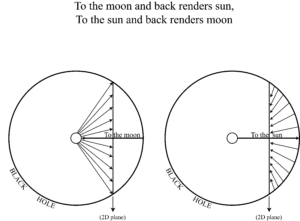The central nugget of these ideas is simple. What we perceive as light may not be light proper (light as light or light qua light). What we perceive as light may be more in keeping with what Plato describes in Book VII of The Republic, in his allegory of the cave. This hypothesis incorporates the idea that what we perceive with our senses is an image that is being rendered, which is supported by contemporary cognitive science, neuroscience, and quantum information theory.
Light’s speed is always a round-trip measurement.
Light that travels “to the moon and back” (what we call sun?) has speed. Light that travels “to the sun and back” (what we call moon?) has speed. But does light as itself—light qua light—have speed? Perhaps light has speed only in relationship to an observer.
This approach to disease is not about the images our brains create; it is about the mathematics behind the images—the scalable relationship. When moon is the pit of time’s cone, earth is the neutral (“sea level”) plane, and sun is the domed mouth. Or: when earth is the pit, sun is the plane, and black hole is the domed mouth. In the opposite direction, if we scale inward and make earth the black hole boundary, the center of the earth is the pit, and the plane of intersection occurs at the 37th parallel.
Is our universe inside a black hole? Some physicists, including Nikodem Poplawski, think so. Black hole cosmology, originally proposed by poet and physicist Raj Pathria and mathematician and cryptologist Irving John Good, requires that the Hubble radius of the observable universe be equal to its Schwarzschild radius.
Plato’s prescience: It is possible we see backward.
